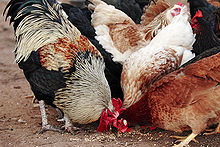


Chelates in animal feed is jargon for metalloorganic compounds added to animal feed. The compounds provide sources of various metals that improve the health or marketability of the animal. Typical metals salts are derived from cobalt, copper, iron, manganese, and zinc. The objective of supplementation with trace minerals is to avoid a variety of deficiency diseases. Trace minerals carry out key functions in relation to many metabolic processes, most notably as cofactors for enzymes and hormones, and are essential for optimum health, growth and productivity. For example, supplementary minerals help ensure good growth, bone development, feathering in birds, hoof, skin and hair quality in mammals, enzyme structure and functions, and appetite. Deficiency of trace minerals affect many metabolic processes and so may be manifested by different symptoms, such as poor growth and appetite, reproductive failures, impaired immune responses, and general ill-thrift. From the 1950s to the 1990s most trace mineral supplementation of animal diets was in the form of inorganic minerals, and these largely eradicated associated deficiency diseases in farm animals. The role in fertility and reproductive diseases of dairy cattle highlights that organic forms of Zn are retained better than inorganic sources and so may provide greater benefit in disease prevention, notably mastitis and lameness.
Animals are thought to better absorb, digest, and use mineral chelates than inorganic minerals or simple salts.[1] In theory lower concentrations of these minerals can be used in animal feeds. In addition, animals fed chelated sources of essential trace minerals excrete lower amounts in their faeces, and so there is less environmental contamination.

Since the 1950s, animal feeds have been supplemented with a variety of trace minerals such as copper (Cu), iron (Fe), iodine (I), manganese (Mn), molybdenum (Mo), selenium (Se), and zinc (Zn). Initially, such supplementation was in the form of inorganic salts of these trace elements, e.g. copper(II) sulfate. Chelated minerals were first developed in the early 1970s, but saw more growth in the 1980s and 1990s. Trace mineral chelates have been shown in some cases to be more efficient than inorganic minerals in meeting the nutritional needs of farm animals.[3] In some cases, chelates offer no advantage however.[4]


The European Union is concerned about possible detrimental effects of excess supplementation with trace minerals on the environment or human and animal health, and in 2003 legislated a reduction in permitted feed concentrations of several trace metals (Co, Cu, Fe, Mn and Zn).[17]